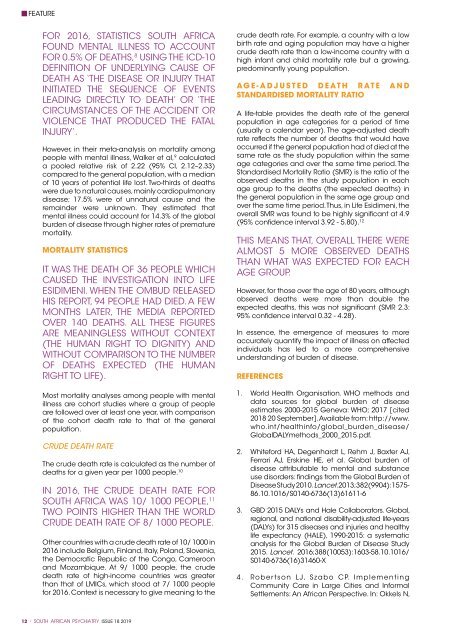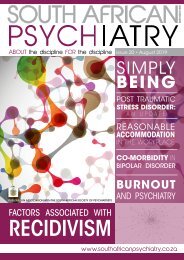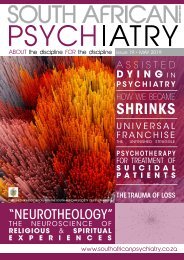South African Psychiatry - February 2019
South African Psychiatry - February 2019
South African Psychiatry - February 2019
You also want an ePaper? Increase the reach of your titles
YUMPU automatically turns print PDFs into web optimized ePapers that Google loves.
FEATURE<br />
FOR 2016, STATISTICS SOUTH AFRICA<br />
FOUND MENTAL ILLNESS TO ACCOUNT<br />
FOR 0.5% OF DEATHS, 8 USING THE ICD-10<br />
DEFINITION OF UNDERLYING CAUSE OF<br />
DEATH AS ‘THE DISEASE OR INJURY THAT<br />
INITIATED THE SEQUENCE OF EVENTS<br />
LEADING DIRECTLY TO DEATH’ OR ‘THE<br />
CIRCUMSTANCES OF THE ACCIDENT OR<br />
VIOLENCE THAT PRODUCED THE FATAL<br />
INJURY’.<br />
However, in their meta-analysis on mortality among<br />
people with mental illness, Walker et al, 9 calculated<br />
a pooled relative risk of 2.22 (95% CI, 2.12–2.33)<br />
compared to the general population, with a median<br />
of 10 years of potential life lost. Two-thirds of deaths<br />
were due to natural causes, mainly cardiopulmonary<br />
disease; 17.5% were of unnatural cause and the<br />
remainder were unknown. They estimated that<br />
mental illness could account for 14.3% of the global<br />
burden of disease through higher rates of premature<br />
mortality.<br />
MORTALITY STATISTICS<br />
IT WAS THE DEATH OF 36 PEOPLE WHICH<br />
CAUSED THE INVESTIGATION INTO LIFE<br />
ESIDIMENI. WHEN THE OMBUD RELEASED<br />
HIS REPORT, 94 PEOPLE HAD DIED. A FEW<br />
MONTHS LATER, THE MEDIA REPORTED<br />
OVER 140 DEATHS. ALL THESE FIGURES<br />
ARE MEANINGLESS WITHOUT CONTEXT<br />
(THE HUMAN RIGHT TO DIGNITY) AND<br />
WITHOUT COMPARISON TO THE NUMBER<br />
OF DEATHS EXPECTED (THE HUMAN<br />
RIGHT TO LIFE).<br />
Most mortality analyses among people with mental<br />
illness are cohort studies where a group of people<br />
are followed over at least one year, with comparison<br />
of the cohort death rate to that of the general<br />
population.<br />
CRUDE DEATH RATE<br />
The crude death rate is calculated as the number of<br />
deaths for a given year per 1000 people. 10<br />
IN 2016, THE CRUDE DEATH RATE FOR<br />
SOUTH AFRICA WAS 10/ 1000 PEOPLE, 11<br />
TWO POINTS HIGHER THAN THE WORLD<br />
CRUDE DEATH RATE OF 8/ 1000 PEOPLE.<br />
Other countries with a crude death rate of 10/ 1000 in<br />
2016 include Belgium, Finland, Italy, Poland, Slovenia,<br />
the Democratic Republic of the Congo, Cameroon<br />
and Mozambique. At 9/ 1000 people, the crude<br />
death rate of high-income countries was greater<br />
than that of LMICs, which stood at 7/ 1000 people<br />
for 2016. Context is necessary to give meaning to the<br />
crude death rate. For example, a country with a low<br />
birth rate and aging population may have a higher<br />
crude death rate than a low-income country with a<br />
high infant and child mortality rate but a growing,<br />
predominantly young population.<br />
AGE-ADJUSTED DEATH RATE AND<br />
STANDARDISED MORTALITY RATIO<br />
A life-table provides the death rate of the general<br />
population in age categories for a period of time<br />
(usually a calendar year). The age-adjusted death<br />
rate reflects the number of deaths that would have<br />
occurred if the general population had of died at the<br />
same rate as the study population within the same<br />
age categories and over the same time period. The<br />
Standardised Mortality Ratio (SMR) is the ratio of the<br />
observed deaths in the study population in each<br />
age group to the deaths (the expected deaths) in<br />
the general population in the same age group and<br />
over the same time period. Thus, in Life Esidimeni, the<br />
overall SMR was found to be highly significant at 4.9<br />
(95% confidence interval 3.92 - 5.80). 12<br />
THIS MEANS THAT, OVERALL THERE WERE<br />
ALMOST 5 MORE OBSERVED DEATHS<br />
THAN WHAT WAS EXPECTED FOR EACH<br />
AGE GROUP.<br />
However, for those over the age of 80 years, although<br />
observed deaths were more than double the<br />
expected deaths, this was not significant (SMR 2.3:<br />
95% confidence interval 0.32 - 4.28).<br />
In essence, the emergence of measures to more<br />
accurately quantify the impact of illness on affected<br />
individuals has led to a more comprehensive<br />
understanding of burden of disease.<br />
REFERENCES<br />
1. World Health Organisation. WHO methods and<br />
data sources for global burden of disease<br />
estimates 2000-2015 Geneva: WHO; 2017 [cited<br />
2018 20 September]. Available from: http://www.<br />
who.int/healthinfo/global_burden_disease/<br />
GlobalDALYmethods_2000_2015.pdf.<br />
2. Whiteford HA, Degenhardt L, Rehm J, Baxter AJ,<br />
Ferrari AJ, Erskine HE, et al. Global burden of<br />
disease attributable to mental and substance<br />
use disorders: findings from the Global Burden of<br />
Disease Study 2010. Lancet. 2013;382(9904):1575-<br />
86.10.1016/S0140-6736(13)61611-6<br />
3. GBD 2015 DALYs and Hale Collaborators. Global,<br />
regional, and national disability-adjusted life-years<br />
(DALYs) for 315 diseases and injuries and healthy<br />
life expectancy (HALE), 1990-2015: a systematic<br />
analysis for the Global Burden of Disease Study<br />
2015. Lancet. 2016;388(10053):1603-58.10.1016/<br />
S0140-6736(16)31460-X<br />
4. Robertson LJ, Szabo CP. Implementing<br />
Community Care in Large Cities and Informal<br />
Settlements: An <strong>African</strong> Perspective. In: Okkels N,<br />
12 * SOUTH AFRICAN PSYCHIATRY ISSUE 18 <strong>2019</strong>
















